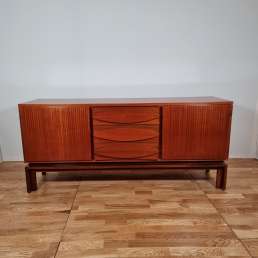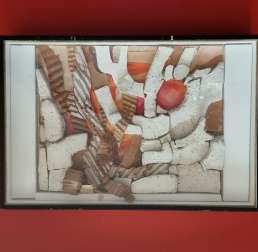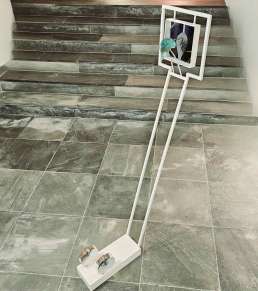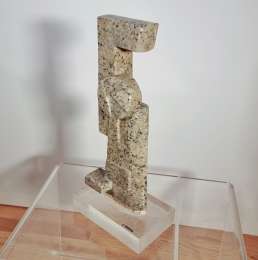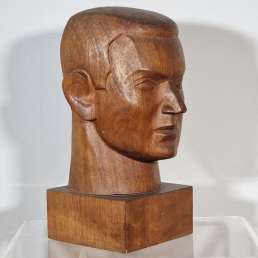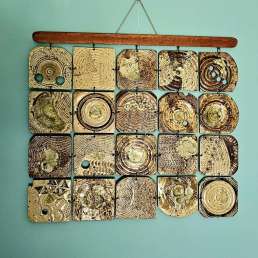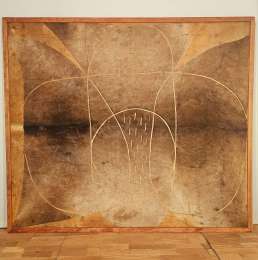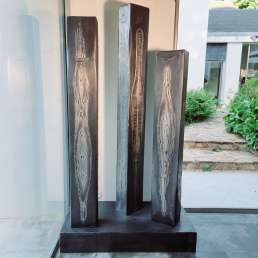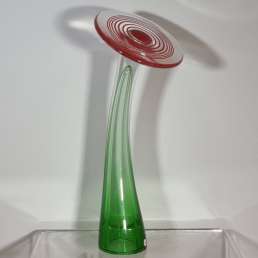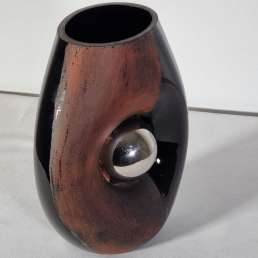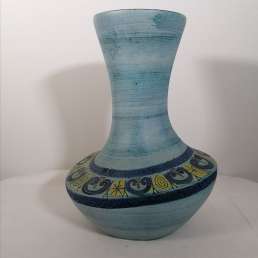Naum KNOP (Brazil, 1917-1993), Adam and Eve, exotic wood sculpture
Description
What I like
I like this sculpture first of all for its composition, very typical of Naum Knop’s work: the bodies are made up of various elements in strong relief, very rounded, of stylized shape, drawing the faces and bodies. Furthermore, I really like this idea of having created this sculpture by sculpting the elements corresponding to the two faces, and glued on a cut-out panel showing the silhouettes: this completely corresponds to the idea of the frame, which gives a monumental to our Adam and Eve.
I love the finesse of the work, the warmth of exotic wood, enhanced by the wax polish.
Finally, I really like the fact of having an emblematic piece by an important Brazilian painter, who has been presented in numerous events both in Brazil and abroad: the existence of a Naum Knop foundation in Buenos Aires and a Naum Knop museum, is emblematic of its recognition.
Technical description
Naum KNOP (Brazil 1917-1993)
Adam and Eve
Sculpture, exotic wood, monogrammed NK on the terrace
Adam and Eve are represented naked, in a square wooden frame, a light festoon representing the sky; the two characters rest on a small base with stylized tiers; monogram at the bottom of this frame. The whole rests on a solid base whose front facade is scalloped at the front.
Under the base, label bearing the name and address of Naum Knop, very faded, as well as a Subasta sales label from Arte Latinomericano, Odalys.com, n°152- Spain.
Tiny crushing of one of Adam’s nipples.
Dimensions and weight
Height: 42 cm – Width: 41,5 cm – Depth: 12,5 cm
Weight:6 kg
Mix & Match
This sculpture by Naum Knop is monumental despite its medium-sized dimensions. The idea of placing the two figures in a frame and on a scalloped base also makes it a piece of art whose contemplation will delight! Here are my tips:
1. To see both sides, it would be ideal to place it on a coffee table, such as Domustil’s bar table (see photo and link below).
2. Find furniture to match the warmth of its wood, such as the beech of the 1940s-50s armchairs with their plum-colored embroidered cover by Lesage (see photo and link below).
3. Match it with a wall decoration in harmony of tone, such as Enrique Broglia’s “Composicion metalica” (see photo and link below), which serves as a stunning counterpoint with its brown, beige and gold palette!
4. Use sculpture to liven up the top of a piece of furniture, like our “Œil” sideboard by André Joseph Motte: the varnish of the sideboard’s mahogany and the waxed finish of Knop’s sculpture are two ways of taking advantage of exotic woods.
Description
To know more
The sculptor
Naum Knop was born in 1917 in Buenos Aires, into a family of Russian origin originally from Ukraine. His childhood took place in the La Paternal neighborhood, where his father owned a carpentry workshop, a space where he first came into contact with the technique of wood sculpture. After completing his primary studies, he worked with Professor Luis Fernández and soon after devoted himself to furniture design. Around 1935, he entered the Manuel Belgrano School of Fine Arts. Between 1941 and 1942 he followed the master’s course taught by Alberto Lagos and Alfredo Bigatti at the National School of Fine Arts and continued his training between 1942 and 1945 at the Ernesto de la Cárcova Superior School with Soto Avedaño, Carlos de la Cárcova and José. Fioravanti. At this time, he put his works in dialogue with other young artists like Libero Badii and Aurelio Macchi.
Around 1947, he made his study trip. He went to California, in the United States, where he entered the Art Institute of Los Angeles. At the same time, visit museums and galleries. In January 1948, he organized his first exhibition abroad, at the Hall of Arts in Beverly Hills in Los Angeles. During this period, he toured Chicago and then New York. That year, he traveled to Europe; His itinerary includes France, Italy, Switzerland and England. He thus came into contact with the works of Henry Moore, Jean Arp, Jacques Lipchitz, Constantin Brancusi, Umberto Boccioni, Henry Laurens, Ossip Zadkine. Artists who left their mark on the young Knop and to whom he paid homage in his later production. He returned to Argentina in 1949 and set up his workshop where he worked on ornamental sculpture and pieces in which he oscillated between synthetic figuration and abstraction.
In 1956 he began his successful participation in trade fairs, obtaining numerous awards at the national and municipal level. In 1959, he participated in the candidacy for the V Biennale of São Paulo and since then, to the success obtained at the local level, have been added the multiple exhibitions organized in the international field. The exhibitions in Tel Aviv, Jerusalem and Rome (1966) are remarkable; Dusseldorf (1977); Los Angeles and Palm Spring (1981); New York (1986), San Pablo and Los Angeles (1989). During this period, his work acquired maturity, as he began to experiment with the direct wax technique, obtaining textured, weld-like surfaces that gave it a strong expressive character. Alongside his personal production and small modeling, the artist receives private and public commissions for which he works on large sculptures and murals.
Around 1967, the architect Mario R. Álvarez invited him to participate in a closed competition for the creation of a work that would be located in the General San Martín Cultural Center. Libero Badii and Enio Iommi participate alongside the artist; the elongated bronze figure of Knop is chosen. Among the large-scale monuments, it is worth remembering the work The Three Suns, temporarily located in Recoleta in 1984 and later installed in Maryland, United States; as well as Seated Figure (Reminiscence of Michelangelo) located in the escutcheon of a private building in 1970. Added to this are the numerous murals in which he experiments with various materials and techniques such as bronze casting, reliefs openwork and wood and cement work.
Additional information
| Weight | 6 kg |
|---|---|
| Dimensions | 12,5 × 41,5 × 42 cm |














